You’d be hard-pressed to find an organization that didn’t want its sellers and sales teams to meet their goals in the face of challenging conditions and do so with high win rates and strong pricing.
Sales training is one obvious way for organizations to build such teams. While sales training often fails to meet its promise, our research shows that highly effective sales training is correlated with higher win rates, sales goal attainment, and premium pricing.
But a big challenge for organizations seeking to build a high-performing sales team is identifying which specific sales capabilities to develop in their sellers. Of the many skills development and training options available internally or externally, which should be prioritized to support sellers to become Top Performers?
The good news is that through the RAIN Group Center for Sales Research, we’ve identified sales skills that correlate with Top Performance and created a sales competency model that organizations can use to develop their sellers into a team of Top Performers.
Download The Top-Performing Seller Research Report. >>
Crafting a Sales Training Curriculum
Organizations that use a competency model in their sales training and development have a head start when it comes to crafting their sales curricula.
Almost all sales force training needs can be defined in advance once you know what your sellers need to do and produce. If you know what they need to do, you can define the required knowledge, skills, and attributes. If you've defined the skills, knowledge, and attributes, you can define the content and format of training programs best suited to develop them.
An early step in the process is to build a sales competency model to understand the skills your sellers need.
There are numerous sales competency model frameworks, and we have our own research-based model we use with clients. Regardless of which you choose, having a competency model in place for each sales role allows you to clearly define what a great seller looks like. Then you can build their skills to get there.
Unfortunately, a lot of sales training is done on little more than a whim. Then, next quarter or next year, another whim leads to another “priority” training roll-out. When this happens, sellers tend to dismiss the importance of training because whatever was critically important two months ago is now off the radar screen.
However, using our research-validated Top-Performing Seller and Top-Performing Sales Managers models to build your training curricula can help address this problem.
Sales Competency Framework: The Top-Performing Seller Model
We studied 100 skills and behaviors across 13 categories and found Top-Performing Sellers are statistically significantly more capable in the following critical categories of selling:
- Selling Across the Sales Cycle
- Opportunity Management
- Account Management
- Relationships, Conversations, and Influence
- Productivity
The Top-Performing SellerSM Model
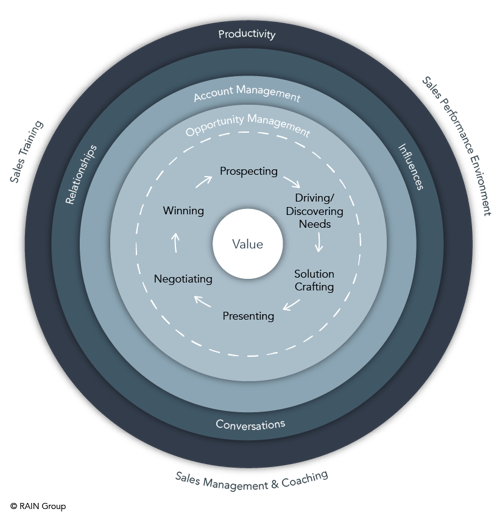
Who Are the Top Performers?
What do Top-Performing Sellers, those who achieve stronger sales results compared to other sellers, do differently?
After years of studying sellers and sales organizations across the world and across industries, and analyzing data from thousands of sellers and sales managers, we organized an expansive, global study of over 1,000 sellers and sales managers.
The goal: find out exactly what Top-Performing Sellers do differently and better than other sellers, and learn what organizations do to inspire the best performance from their selling teams.
The Top Performer group represents 18.7% of research participants. The Rest, everyone else, represents 81.3% of participants.
We assessed the skills and behaviors of sellers based on their own responses, as well as those of sales managers responding about their sales team.
In our study, the criteria for top performance included:
- Annual sales goal: Top-Performing Sellers met their annual goal. For sales managers reporting for their team, 75% or more of team members met their goal.
- Challenge: Sales goals must have been challenging.
- Win rate: Average win rate on proposed sales was greater than 50%.
- Pricing: Premium pricing was achieved.
Based on the definitions shared previously, Top Performers achieve superior sales results compared to The Rest.
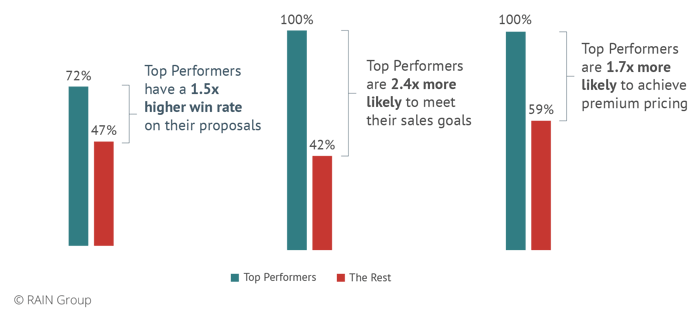
Let’s take a closer look at the capabilities of Top Performers, starting at the center of The Top-Performing Seller model and working outwards.
Achieving the Outcome: Value
At the center of all consultative selling is value.
Sellers are often told to focus on value when selling, but many sellers and sales managers don’t truly understand what value is. At RAIN Group, we define value as the collection of reasons a buyer buys from you, and we view it through the buyer’s lens.
According to other research, the factor that distinguished sales winners and drove buyer satisfaction, likelihood to buy again, and likelihood to refer was that the overall value from the company was superior to other options.
In the sales skills research, we focused on uncovering the seller capabilities that lead to the outcome of delivering maximum value in the eyes of the buyer—in other words, those capabilities that allow sellers to resonate, differentiate, and substantiate with buyers.
As a result of their approach to selling, Top Performers understand and make the value case more strongly. The data shows they have significantly stronger skills to drive both the perception—and reality—that the value of buying from them is higher than buying from others.
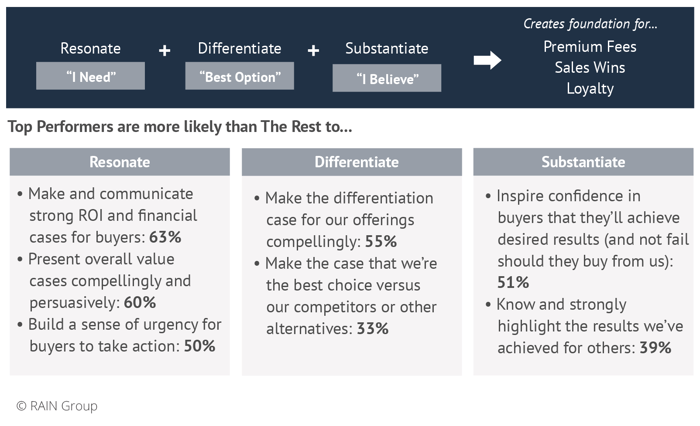
Winning the Sale
The data show that when it comes to opportunity management and selling across the sales cycle, Top Performers possess both depth and breadth in their selling capabilities.
The Selling Process

For example, Top Performers are more likely than The Rest to excel at prospecting, needs discovery, solution crafting, solution presentation, negotiating, and winning:
Prospecting:
- Generate referrals (63%)
- Energetically prospect over the long term (50%)
- Implement organized prospecting campaigns (44%)
Driving & Discovering Need:
- Maximize cross- and up-sells (65%)
- Change buyer thinking about needs (60%)
- Lead thorough needs discoveries (58%)
Solution Crafting:
- Collaborate with buyers deeply across the buying process (59%)
- Influence buyer thinking about what to buy (57%)
- Build excellent responses to RFPs (52%)
Solution Presentation:
- Communicate strong, defensible ROI cases (63%)
- Make the overall value case (60%)
- Make effective differentiation cases (55%)
Negotiating:
- Know when to walk away (105%)
- Manage their own and buyer emotions (105%)
- Overcome price pressure and maintain margins (81%)
- Lead the negotiation process (71%)
Winning:
- Lead highly effective finalist presentations (65%)
- Build a sense of urgency for action (50%)
- Outsell the competition in competitive bids (41%)
- Gain commitment: Top Performers achieve higher average win rates on proposed sales (72% compared to 47% for The Rest)
Ultimately, it’s not any one capability that distinguishes the best sellers, it’s a mix of capabilities. Top-Performing Sellers have stronger capabilities across the sale cycle.
Along with performing successfully in each stage of the sales process, sellers must also manage their opportunities—especially their most important opportunities—in deliberate ways to maximize their win rate.
Most sellers have felt the frustration of seeing a buyer they believed should have bought from them buy instead from someone else. Often this is because the other seller simply out-planned, out-maneuvered, and outsold them.
Sellers who skillfully and deliberately manage their sales opportunities win more sales overall and win more competitive bids.
The research shows that Top Performers are 29% to 65% more likely to excel at opportunity management skills compared to The Rest. For example, Top Performers are more likely than The Rest to:
- Lead highly effective proposal and finalist presentations (65%)
- Adjust their selling process to better align with the buyer’s buying process (60%)
- Develop buyer champions to advocate for us to help us win the sale (57%)
- Pursue opportunities with the right intensity (48%)
- Develop strong action plans to win our most important sales opportunities (48%)
- Uncover decision makers (43%)
Driving Account Growth: Account Management
While not all sellers manage accounts, for those who do, Top Performers have much stronger account management skills than The Rest.
Selling to existing, satisfied customers is much easier than selling to potential new customers. Company leaders often tell us that there’s significant untapped value and growth within existing accounts. They lament that sellers don’t surface the untapped need and don’t engage existing customers nearly enough to expand the business the company does with them.
Look at the chart below. It’s not difficult to imagine that sellers who are better at proactively leading the account growth process, developing enterprise-level relationships, identifying where they can drive additional value, and then building compelling account plans and executing them are much more effective than those who don’t.
Account Management Capabilities of Top Performers
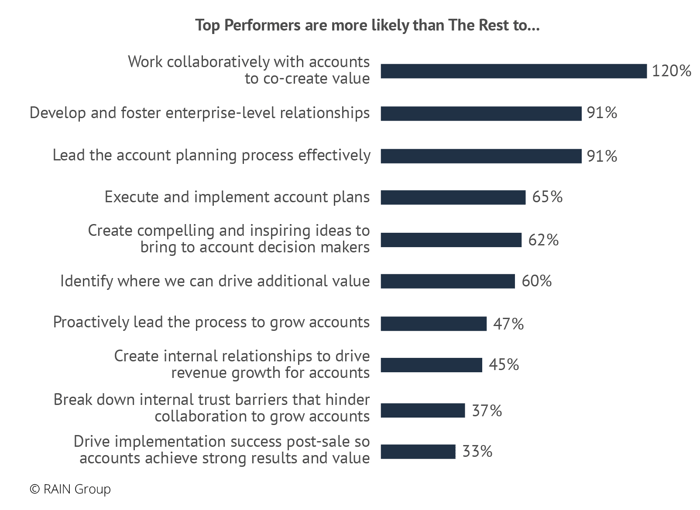
Succeeding with People: Relationships, Conversations, and Influence
The best sellers are great with people. They maintain strong relationships with influential executives and referral sources, regularly have valuable conversations, and influence people to take action and pursue priorities that are most helpful to them.
Top-Performing Sellers are more successful and influential when interacting with key people during the selling process and even outside of it.
Top Performers are more likely to excel at:
- Relationships, including developing enterprise-level relationships (91%)
- Conversations, including leading effective sales conversations (62%)
- Influencing buyers, including making strong ROI cases (63%) and collaborating deeply with buyers across the buying process (59%)
Maximizing Personal Effectiveness: Productivity
While the topic of sales productivity is popular among sales enablement and sales leadership, the conversation frequently focuses on technologies that can help sellers work faster and spend less time on non-selling activities. It often doesn’t focus on how sellers work, day in and day out, to produce the best results.
But it should.
Perhaps the most surprising finding of our research is the correlation between sellers’ productivity behaviors and habits and their likelihood to be Top-Performing Sellers.
Top Performers have much stronger productivity behaviors and habits than The Rest.
Productivity Habits of Top Performers
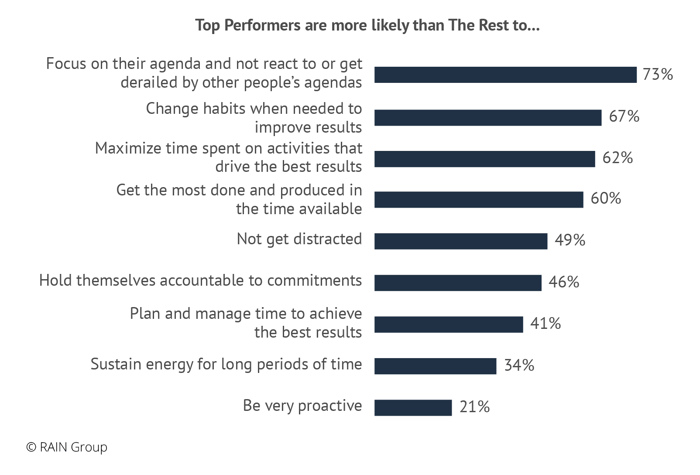
Learn more about Unlocking the Productivity Code. >>
External Influences on Sales Competencies
On the outside of the model, there are three major factors that influence competency mastery:
Even if you select a great competency model and get buy-in, it’ll fall flat without the right support. You need effective training to train sellers to the skills in the model, and effective managers who coach on a regular schedule to reinforce the learning and hold sellers accountable.
In fact, sellers with an effective manager, regular coaching, and effective sales training are 63% more likely to be Top Performers.
Impact of Manager + Coaching + Sales Training on Seller Performance
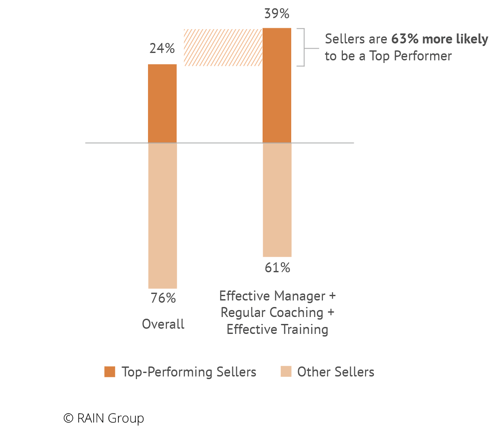
Benefits and Challenges of Building a Sales Competency Model
There are multiple benefits to having a competency model for your organization’s sales professionals, including:
- Improved performance: Defining the key skills and behaviors required for success in sales can help sales professionals focus their efforts and improve their performance.
- Aligned expectations: Providing a clear understanding of what’s expected of sellers helps align expectations between sellers and their managers.
- Consistency: When sellers work to the same standards and expectations, it results in greater consistency in sales performance.
- Training and development: Using a model to guide the development and training of sellers ensures they have the skills and knowledge required to succeed.
- Hiring: A model can inform the hiring process by identifying the key skills and behaviors important for success in a sales role.
- Performance evaluation: A competency model can be used to evaluate the performance of sales professionals, helping managers identify areas for improvement and provide feedback.
Overall, a sales competency model provides a clear and consistent framework for sales professionals, enabling organizations to develop and evaluate their sales teams and ultimately improve performance.
However, building one is not without its challenges, including:
- Defining the right competencies: Identifying the right set of competencies can be difficult as different sales roles may require different skills and behaviors.
- Ensuring relevancy: The model must be relevant to the organization's products, services, and customers. It must take into account the unique challenges and requirements of the sales role.
- Staying current: As market conditions change and technology evolves, organizations must continually review and update their competency models to ensure they remain relevant.
- Obtaining buy-in: Getting buy-in from sales professionals and their managers can be a challenge as they may resist change or not see the value of the model.
- Implementing and reinforcing: Ensuring that the model is consistently implemented and reinforced across the sales team can be challenging, especially if different managers have different interpretations of the model.
- Measuring and evaluating: Developing and using effective methods for measuring and evaluating sales performance against the competency model can be difficult and may require significant resources.
- Balancing specificity and flexibility: While the model needs to be specific, it also needs to be flexible enough to accommodate individual differences and varying sales situations.
Organizations need to be prepared to invest time and resources into developing and implementing a competency model and address these challenges head-on to ensure its success.
A Roadmap to Crafting a Sales Curriculum for Top Performance
At RAIN Group, we use the research-validated Top-Performing Seller model to help our clients identify the capabilities and gaps in their sales teams. From there, we design focused and relevant curricula so sales training initiatives will be highly effective, resulting in lasting behavior change and generating desired results.
Your organization can use The Top-Performing Seller model, too, as you craft your sales training curriculum. For more help, contact us or download The Complete Guide to Successful Sales Training Success.






